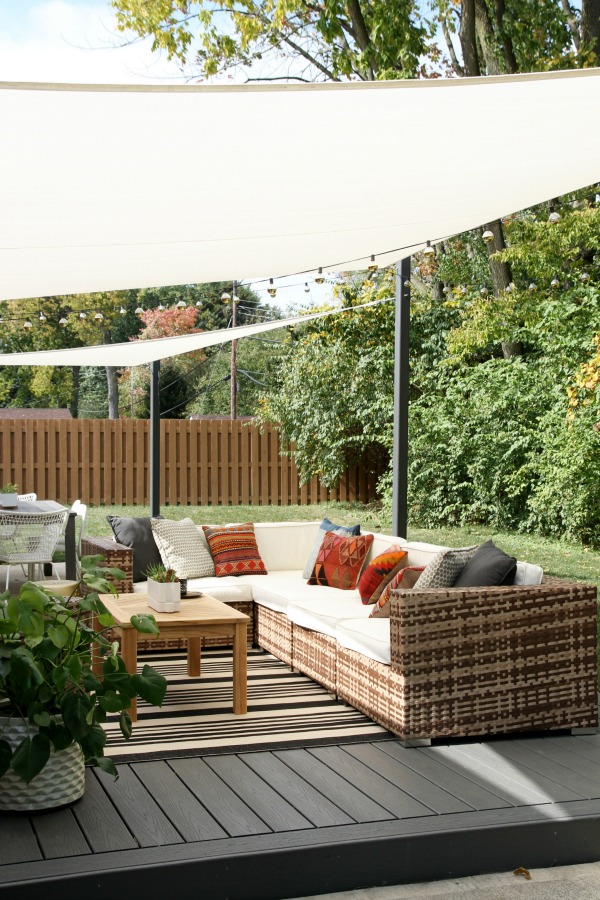
If you’re a longtime reader (thank you!) you know we’ve been planning to add shade sails to the backyard for a while. Even though the back of our house faces north, we’ve discovered that a high summer sun reaches the deck and heats up the space pretty quickly. The Trex composite gets super hot in direct sunlight, and if you’ve learned anything from this blog it’s that I’m barefoot 95% of the time as is the rest of my family. Smokin’ deck + naked feet = no bueno. Not only that, we knew shade would help make the air feel cooler, too. (In fact, up to 15º cooler! Did you know that?) It seemed like a shame to have this great outdoor space but not feel comfortable in it during prime deck season.
We considered a modern pergola (similar to this) or a retractable awning (similar to this) or even a combination of the two (something like this) but ultimately settled on shade sails because we thought they’d look better on our squatty ranch, cost less and require less maintenance. Plus, we’ve always liked them everywhere we’ve seen them. They feel a little less rigid and have more of a playful design.
A few friends and readers suggested checking out Costco’s shade sails and we did (along with other ready-to-hang versions from other retailers). But after considering our needs and what we were hoping to accomplish, we decided larger, custom sails with robust hardware would be the best option for us. We had a local company (Miami Valley Shade Sales if you’re local) come out last year to give us a free estimate. We had sticker shock over the $4,130 price that was quoted to us for two sails plus installation. (!) That’s when we started researching a full or partial DIY installation. Still, the estimate proved to be extremely beneficial. The company took measurements and gave us recommendations for the overall design, post placement and sail shape/height.
Steve gets all the credit for this project. My only input was on the sail design and lending an extra pair of hands to set the posts. He researched the hardware, posts and sails. He’s an engineer, so this project was right in his wheelhouse. Stuff like this is fun for him. Being married to an engineer has its perks.
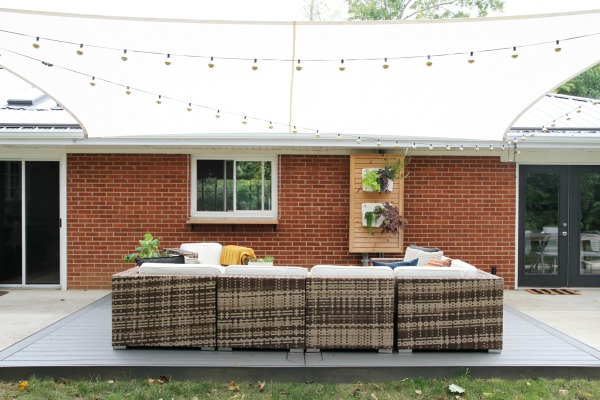
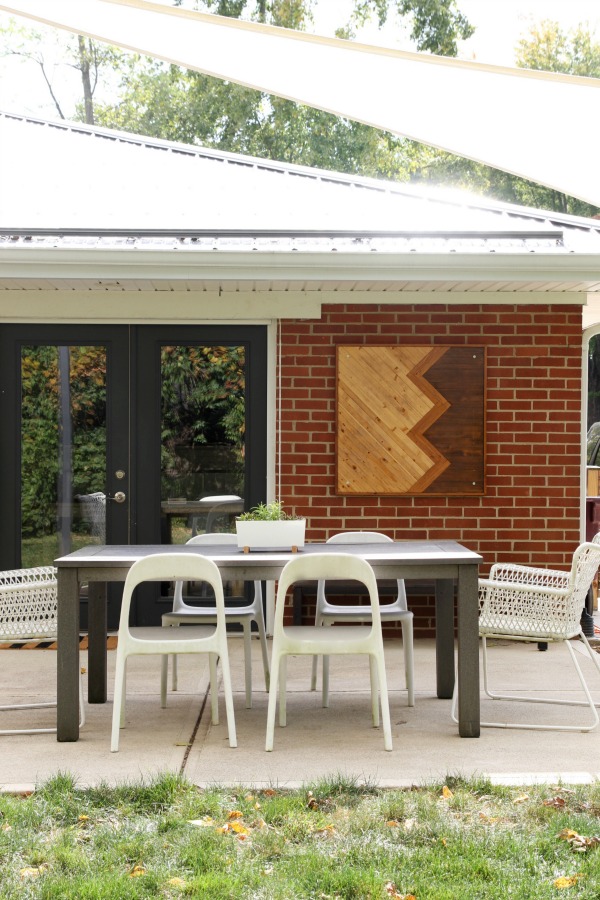
We ended up with a large rectangular sail above the deck and a smaller triangular sail above the dining patio. In the early stages of planning, we thought we’d do three sails (a large rectangle and two smaller triangles overlapping the patio) but when we started mapping things out three sails felt a little crowded in our modest yard. We figured we could always add a sail, so we decided to do two sails and see how we liked them before investing in a third.
Our setup posed a few challenges because we were pretty much forced to tie in all the sails to the fascia of the house. You can add a mounting post to the roof that sits higher, but since we have a vaulted ceiling inside it would’ve involved tearing into that which sounded like a terrible idea to us. Instead, we installed two adjacent corners of the rectangle sail at the same height off the eave and slanted the sail upwards toward the backyard/north. We weren’t able to twist it into a parabola as is most commonly done.
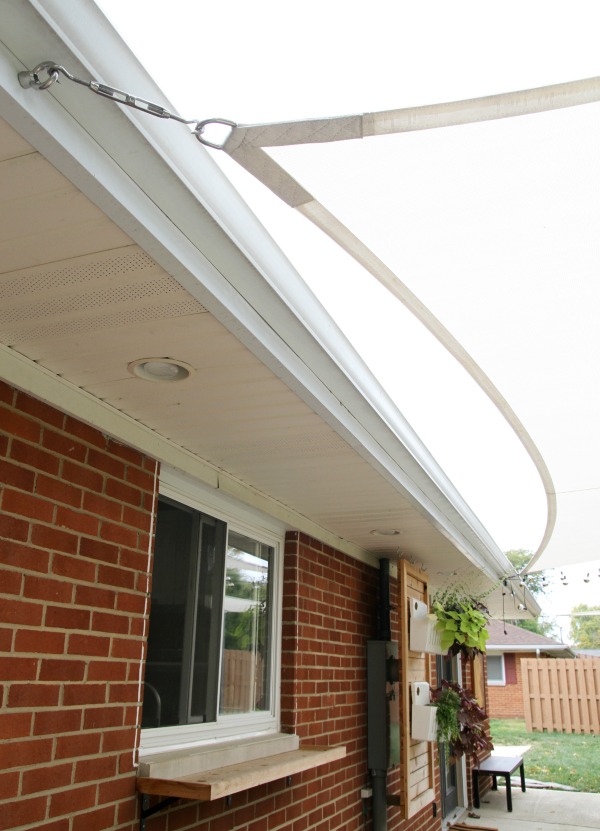
The deck sail is anchored to the eave by two heavy duty rings. We purchased the hardware for the house (eye bolts, eye nuts, rafter brackets) from Shazeebo and actually installed it last year. (See more here and how awesome is that company name, Shazeebo?! It’s my new favorite word.) This required pulling down sections of soffit, drilling holes through the fascia and then bolting the rafter brackets to the rafters. There wasn’t a ton of room to work with at the end of the rafters, so Steve used a 90º drill and ratchet set to tighten everything down.
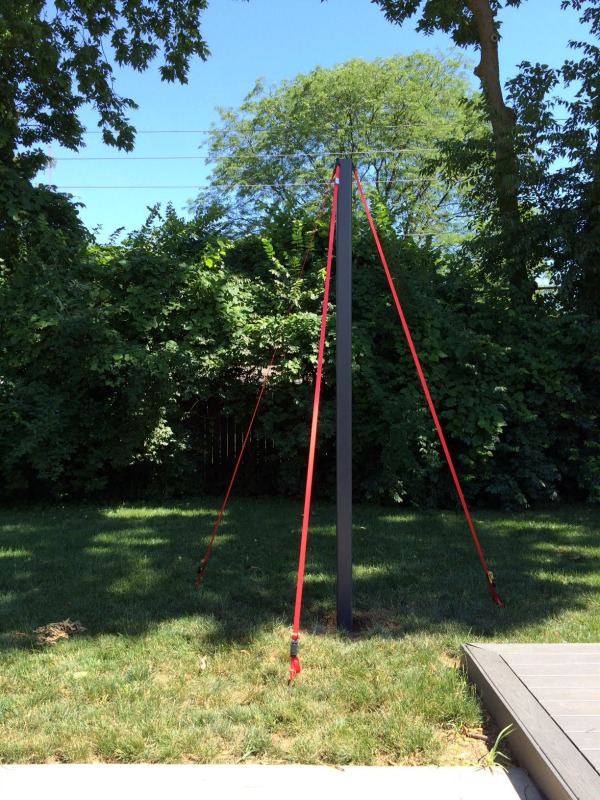
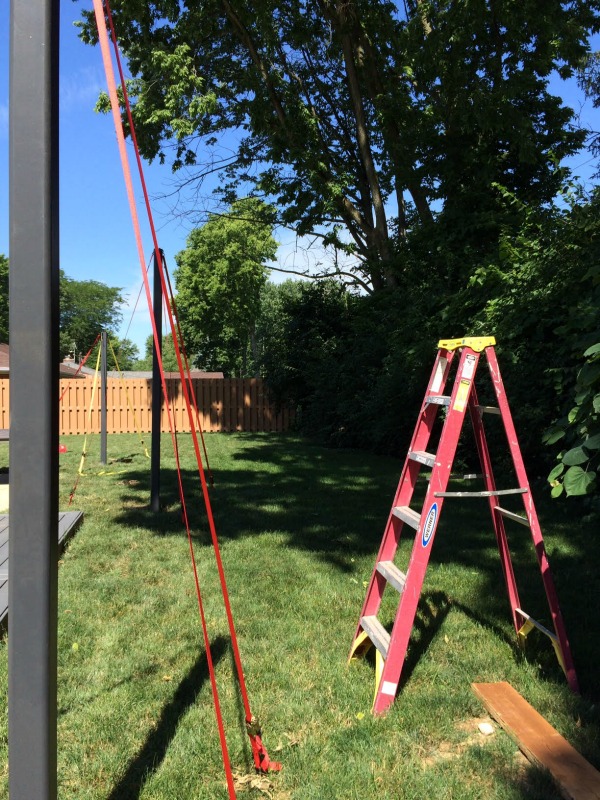
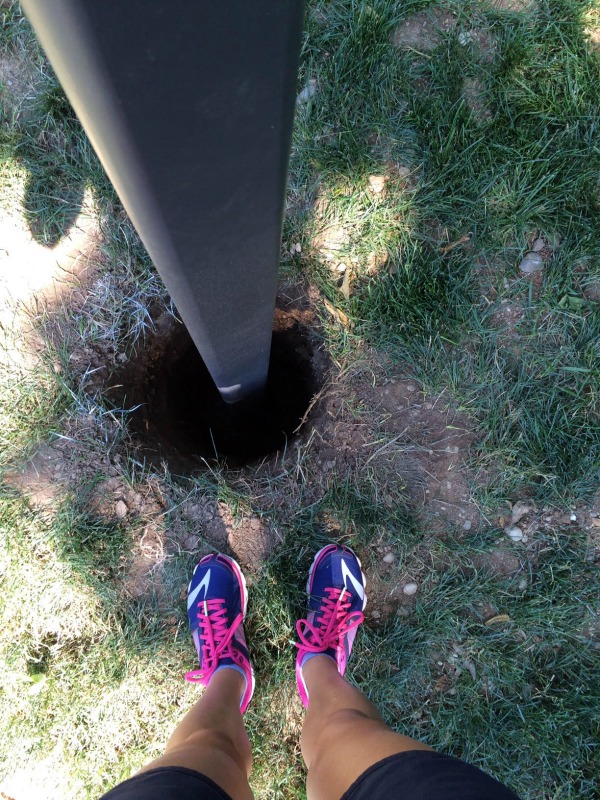
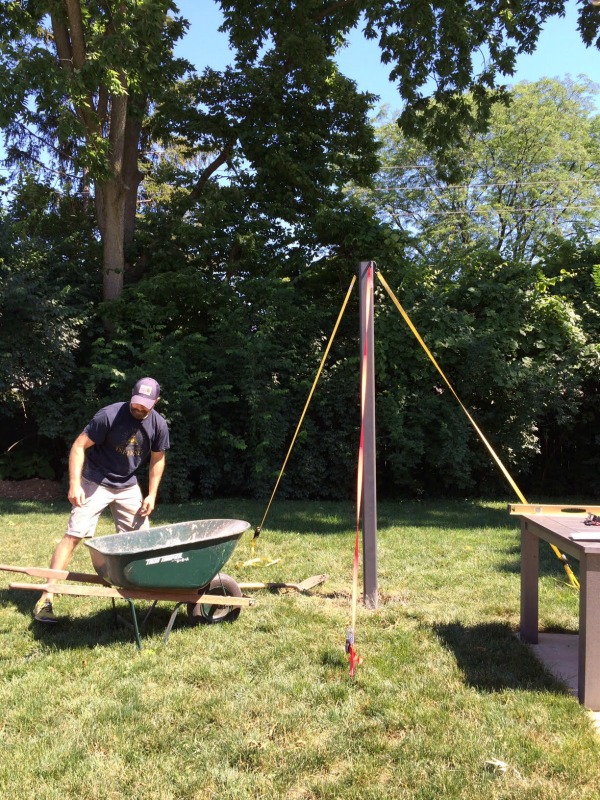
The posts are actually three 4″ x 4″ steel square tubes with .313 thickness. The two nearest the deck are 14′ long and the one off the corner of the dining patio is 12′ long. Steve bought them locally from Industrial Tube & Steel in West Chester, Ohio, the cheapest source he could find. We had to borrow my dad’s trailer to pick them up. They were HEAVY! Steve laid the posts up on sawhorses in the garage (who are these people who actually park cars in their garage?!) over the winter last year and gave them three coats of paint. He used paint leftover from painting all the exterior doors. It’s ‘evening hush’ mixed in the Behr ultra premium plus exterior enamel line in a satin finish.
Earlier this summer we rented a one-man auger to dig the holes and Steve’s quote, not mine, “It was a pain in the ass.” It was obvious it was an older model. A newer one probably would have worked better, but the one we rented was tired. Steve ended up hand digging most of the holes. The powers that be suggested burying the post 1′ for every 2′ above ground. We didn’t get quite that deep, but it’s close and the posts are well below the freeze line. It was also recommended to set the posts a half bubble off vertically due to tension, even for steel tubing. The posts will bow a bit once sails are hung.
We worked together to carry and set the posts. They were super HEAVY!! We probably could/should have had more hands on deck, but once we start something we’ll do just about anything to finish it ourselves…including break our backs. There was a lot of shimmying and tweaking and checking the level to get the posts set just right. Once we had a post where we wanted it, I made like a statue holding it in place while Steve hooked ratchet straps to the top of the post and secured them to stakes in the ground. When all three posts were up, Steve poured the concrete and let it set. Then he drilled holes at the tops of the posts at pre-determined heights and added the eye bolts and eye nuts. Lastly, he installed square snap-in caps to the tops of the posts to prevent them from filling with rain.
Our backyard was wide and shallow to begin with, so we don’t feel like we sacrificed all that much yard space by setting the posts. Other than jumping on the trampoline, the kids mostly play and run in the front yard which is much larger.
FYI – During our post-setting efforts I failed to snap a pic of the tops of the posts, but here’s a shot I took just this (rainy) morning.
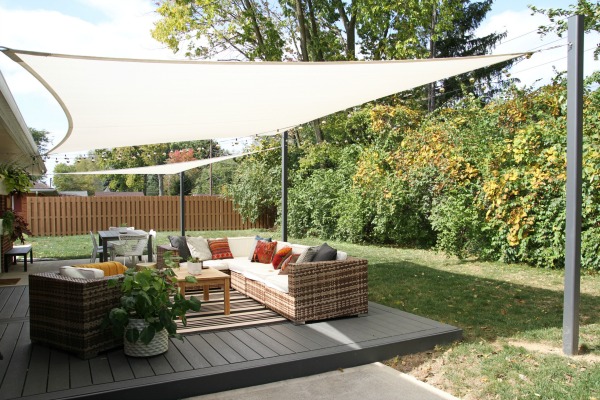
Once the posts were set, we measured for and ordered the custom sails from Sail Shade World (totally unsolicited) based on cost, quality and customer reviews. If shade sails are something you’re considering, keep in mind you cannot order custom sails until after your posts and anchor points are set. It’s critical to get accurate measurements with the posts and anchors in place. Otherwise, you could end up with sagging sails or sails that are too taut. Both scenarios compromise the stability of the sail. Sail Shade World has extremely thorough instructions on how to take proper measurements. We measured everything probably five times to make sure we were doing it correctly.
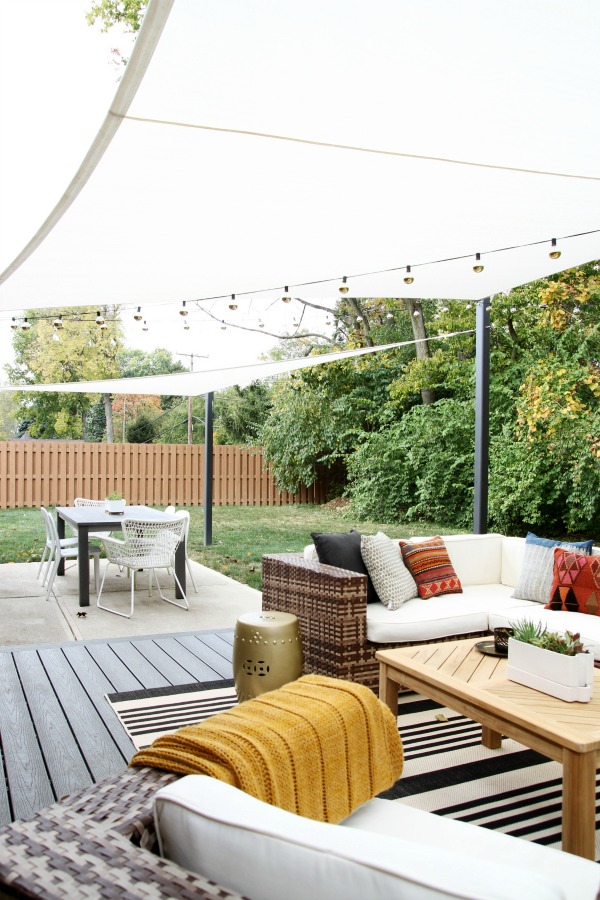
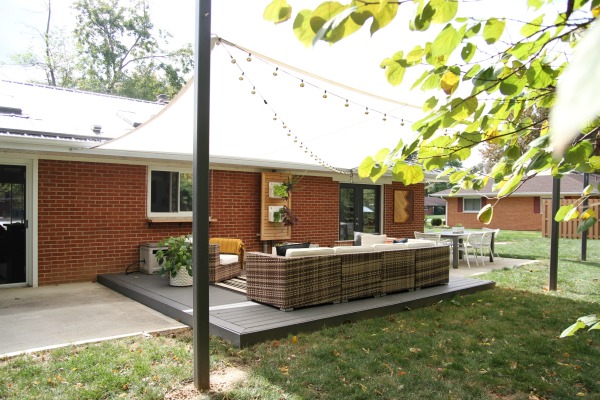
The sails are top of the line as far as quality goes. We selected premium commercial grade 340 g/m² fabric in the natural color for each sail. The heavy duty, maintenance-free fabric has a 10-year warranty against UV-degradation, provides up to 98.8% UV protection and doesn’t hold water. Thick, double-stitched seatbelt webbing along the perimeter and at seams prevents fraying. Marine grade stainless steel rings are stitched into the corners of each sail. The superior fabric and corner rings are what sold us. A few of our neighbors have store bought shade sails less than a year old that are already faded, fraying and sagging. We wanted our shades to last more than one season. Steve even contacted the fabric manufacturer to ask more questions about the hardiness of the sails before we justified the extra cost.
Installation was fairly simple. The sails come with tags so you can correlate them with your measurements. We did have a thread galling issue with the provided turnbuckles. Basically, they quit turning before the proper tension was achieved. Steve contacted Shade Sail World and explained the problem. They were empathetic and reimbursed us for the hardware which allowed us to order heavier gauge turnbuckles from Amazon. The 5/16″ turnbuckles worked great. We’d highly recommend them for a larger sail, especially if the sail will be removed each winter (as ours will).
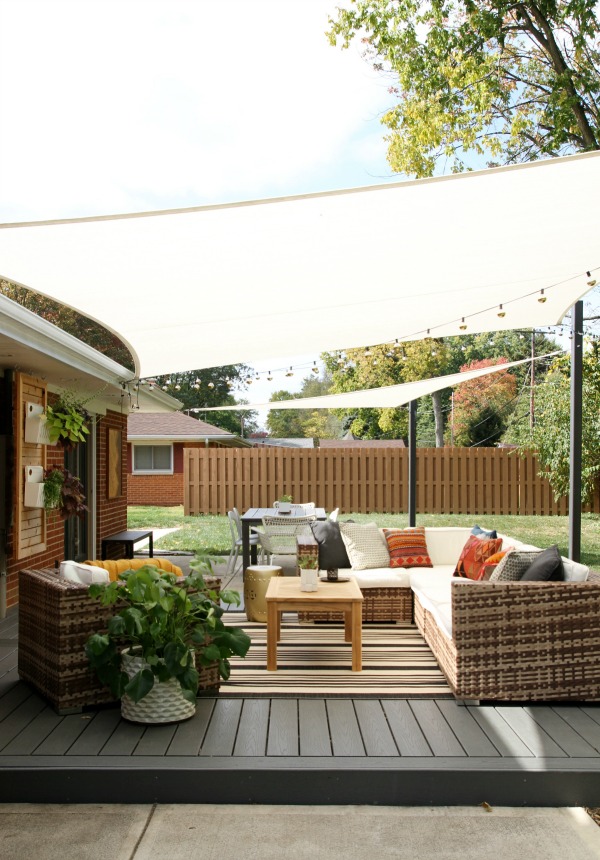
Even though this project spanned a few years from conception to execution, we’re super happy with the results. So far, the sails have held up beautifully. We’ve had several severe storms blow through already and the sails still look brand-new. No fraying, no fading. The outdoor furniture under the sails does get wet when it rains. The sails are purely for shade cover. We’ve been removing the cushions before wet weather strikes for years, so this is nothing new for us. We aren’t sold on a third sail, so we’ll probably live happily ever after with two sails.
We’ve spent more time on the deck in the last two months than we have over the last two or three years combined. If the weather allows, we’re out there. (In fact, Everett has been choosing to do his homework and eat his afterschool snack on the deck.) It feels like an extension of our home and the sails provide a cozy ceiling effect that we weren’t expecting but love so much. For several months out of the year, we gain another room! #sonotreadyforwinter
I wasn’t sure how I would like the slanted vs. twisted rectangular sail, but it’s not as terrible as I thought it might be. It kind of reminds me of a mini amphitheater the way it opens up to the backyard. It keeps the sight lines from the kitchen window nice and open, so I like that. The triangular sail twists down at the western most corner. This is by design. We mostly use the dining patio for al fresco dinners, and the setting sun used to blind us. Now, the slightest dip in the shade sail makes for a squint-free dining experience.
If you promise not to judge, I’ll show you a view from the opposite angle…
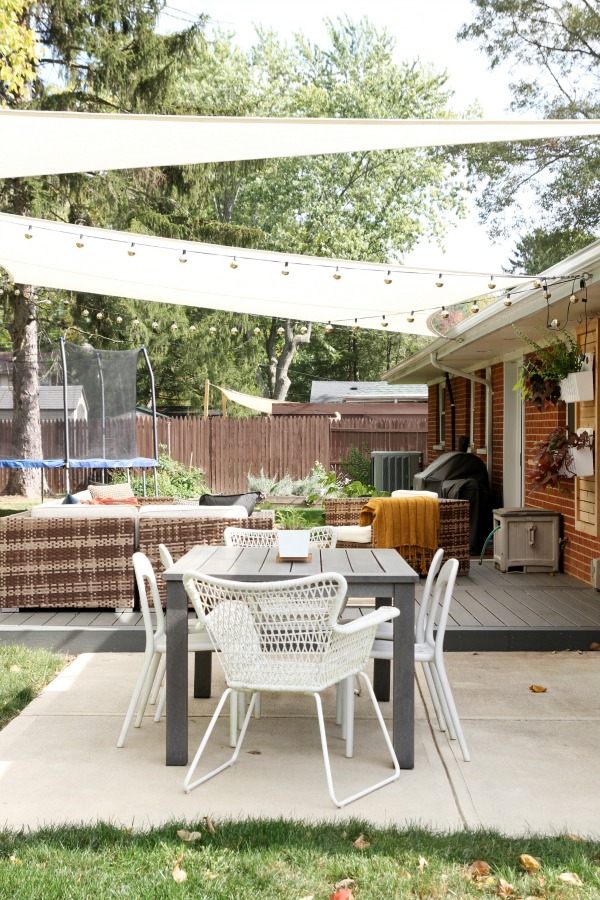
I wish I could snap my fingers and make the hose reel, bulky grill, AC unit and giant purple trampoline (affectionately referred to as Prince Dos) disappear for this shot, but the truth is they’re all things we use on a regular basis so I’d never want to live without them – even though our backyard would look way less cluttered without them. Maybe an AC enclosure is in our future? Or a built-in grill? As long as Prince Dos wears out my kids, he stays. I still wish the neighbor’s fence was charcoal or black. I haven’t had the guts to ask them if I can repaint the side facing our yard like many of you suggested. Oh, can you spy the store bought sail next door?
Now for a cost breakdown:
house hardware – $295
steel posts – $483
post caps – $30
auger rental – $0 (our rental fee was refunded since the auger didn’t work properly)
250″ x 185″ rectangular shade sail – $840
140″ x 195″ x 260″ triangular shade sail – $440
turnbuckles – $100
concrete – $150
TOTAL: $2,338
While definitely not a drop in the bucket, we saved nearly 2K by doing it ourselves. It helps that we broke up our purchases over a two-year period. We like to think of it as the cheapest two-room addition ;)
You may have noticed a few changes to the deck area. I’ll be addressing those in my next post! Stay tuned.
P.S. – Read about how the outdoor furniture is holding up and other backyard adventures here. See our DIY electric meter screen here. Still lovin’ those Woolly Pocket planters.
images: Dana Miller for House*Tweaking
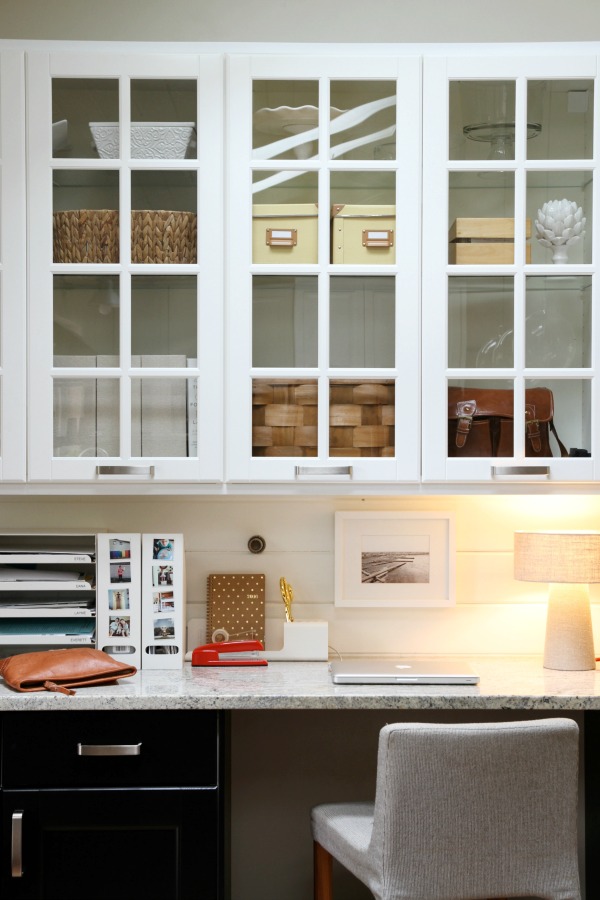
Since downsizing I’ve been asked more than once to share how we handle all the mail, bills, school communication and other paperwork that comes into our home. In all honesty, it takes daily effort and diligence to avoid paper miscellaneous from piling up. But! We have an efficient system in place that makes the task feel less daunting, and it only requires a few minutes of our attention each day. I think the easiest way to share what we do is to document the paper trail to and through our home. Spoiler alert: IKEA is one of my favorite sources for small organizational items. Let’s get started!
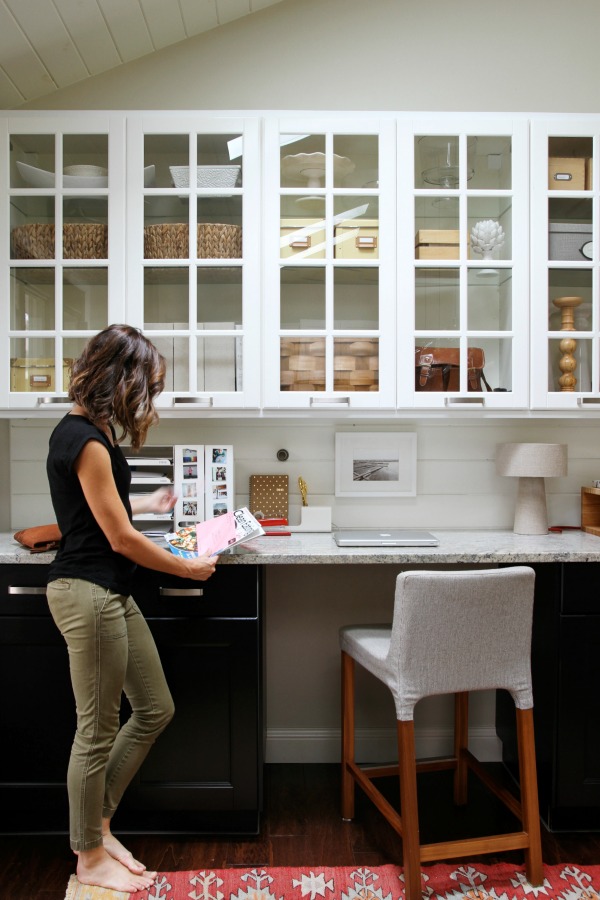
It all starts with filtering what makes it into our mailbox. When we first moved to the city we live in now, we were bombarded with junk mail: catalogs, flyers, coupon mailers, pre-approved credit offers, phone books, etc. Since then, I’ve become adept at noting unwanted mail that shows up in our mailbox then quickly going online and opting out of receiving it again. In the beginning, I was opting out of stuff quite often, but now that it’s under control I maybe opt out of mailings just a few times a year.
A few sites I’ve used to opt out of the majority of junk mail are:
www.optoutprescreen.com To stop receiving pre-approved financial offers. You can opt out for five years or permanently. FYI – If there is more than one adult living under your roof, each adult will need to opt out individually.
dmachoice.thedma.org To stop receiving unsolicited commercial mail from many national brands for a five year period. I’m all for coupons, but I only want coupons for items I would buy regardless of coupon savings. I find that most of the brands and chain restaurants represented in commercial mail aren’t places we normally frequent. Instead of receiving gobs of useless coupons by mail, we usually opt for frequent visitor cards, online coupons and savings apps for stores we normally visit.
www.valpak.com/coupons/show/mailinglistsuppression and www.redplum.com To stop receiving bulk coupon mailers from smaller brokers not registered with the DMA. Mailings from smaller brokers tend to vary depending on your location. These are two of the more popular ones in my area. If you continue to receive coupon offers long after you’ve opted out via the DMA, go straight to the source by googling the broker’s name on your mailings to opt out.
www.yellowpagesoptout.com To opt out of telephone directories in your area. (I can’t believe these still exist!)
Opting out of just these five mass mailers reduces our junk mail by probably 60%-70%. Beyond these, I’ve contacted specific companies directly to opt out of unwanted catalogs. Many catalogs can be viewed online nowadays. Don’t get me wrong. I’m a visual person and I enjoy the tactile process of flipping through a great catalog in hand and gathering tear sheets, but I reserve that guilty pleasure only for my top two or three favorite catalogs. I browse all others online which saves me quite a bit of time and money. No more reading through catalogs like it’s my homework and being tempted to buy stuff I don’t really need or have the space for.
We pay most of our regular monthly bills online automatically via our checking account which deems many physical bills unnecessary. I treat my donation to NPR as a monthly “bill” and have them automatically bill my credit card. As a result, I only receive an annual renewal reminder from them as opposed to several donation requests throughout the year. I’ve called local businesses and churches and kindly asked them to remove my address from their mailing lists. We don’t subscribe to any newspapers, opting to get our news from the radio and online sources instead. Steve and I only subscribe to a few favorite magazines each. I have a hard time reading more than two or three a month before the next issues are out.
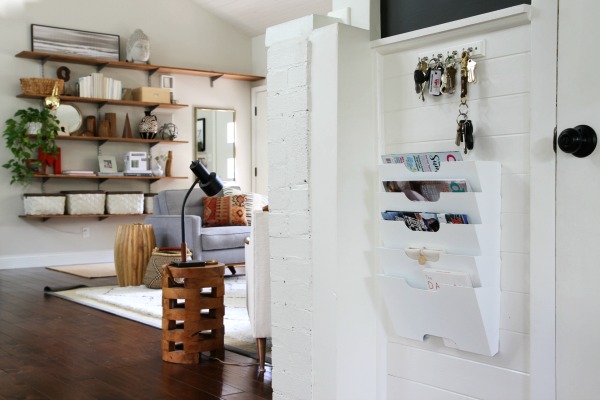
I recently added the KVISSLE magazine rack on a sliver of wall in the mudroom to corral unread magazines, catalogs and stray library books. Before, they kind of traveled all over the house and got lost in the mix. Now, if I have a few minutes to spare or if we’re headed out the door for a long car ride (and Steve is driving, of course) or to an appointment where we might have a wait time, I can quickly grab a glossy and go. No more rummaging around the house trying to find a magazine (I know it’s here somewhere!). No more magazines cluttering horizontal surfaces. Placing the wall rack just below our key hooks makes for a seamless grab-and-go!
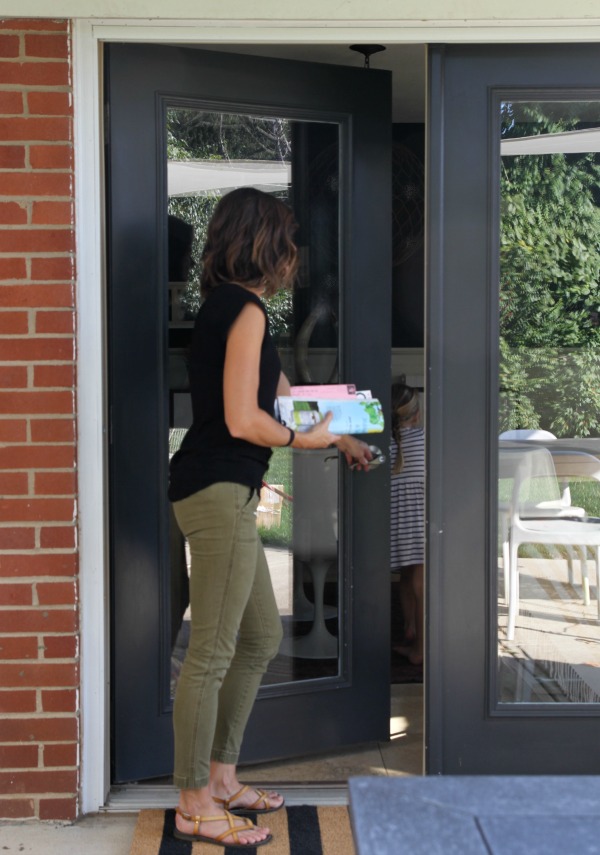
On top of filtering what makes it into our mailbox, I’m also adamant about immediately purging unwanted mail between our mailbox and the back door. On the walk back from the mailbox each day, I make a quick stop at the recycling bin and toss in superfluous junk after noting where it came from so I can opt out of it in the future.
Essentially, by the time any mail reaches our door, it has already been “screened” twice (via opting out and physical sorting) and there’s no need to sort it once inside. I know it reads like an ordeal, but once you get the bulk junk mailings out of the way and take a few seconds to flip through mail just retrieved from the mailbox while still outside, it really runs like clockwork requiring very little time at all.
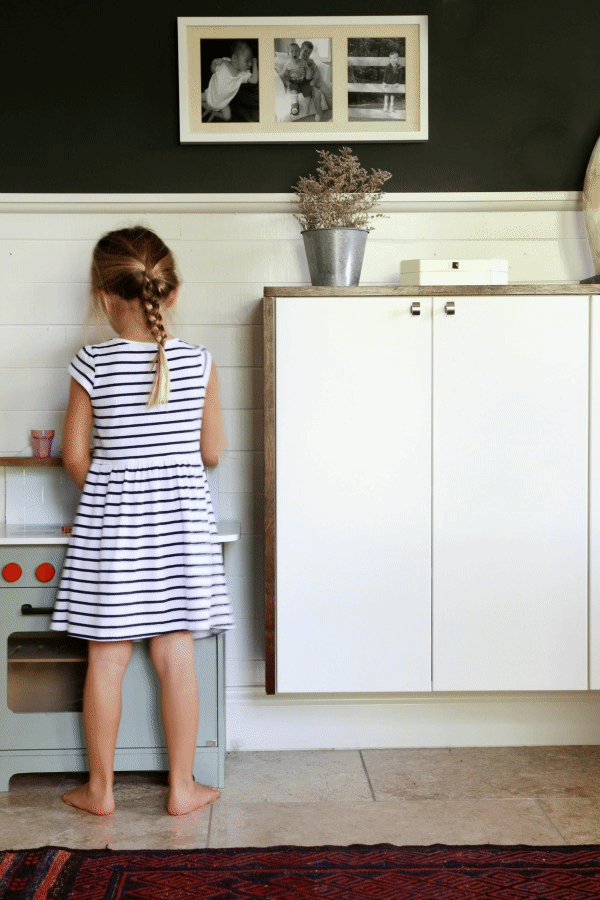
Once inside, I have a strict “no mail on the dining table” rule. One cabinet of the fauxdenza in our mudroom is designated to incoming mail.
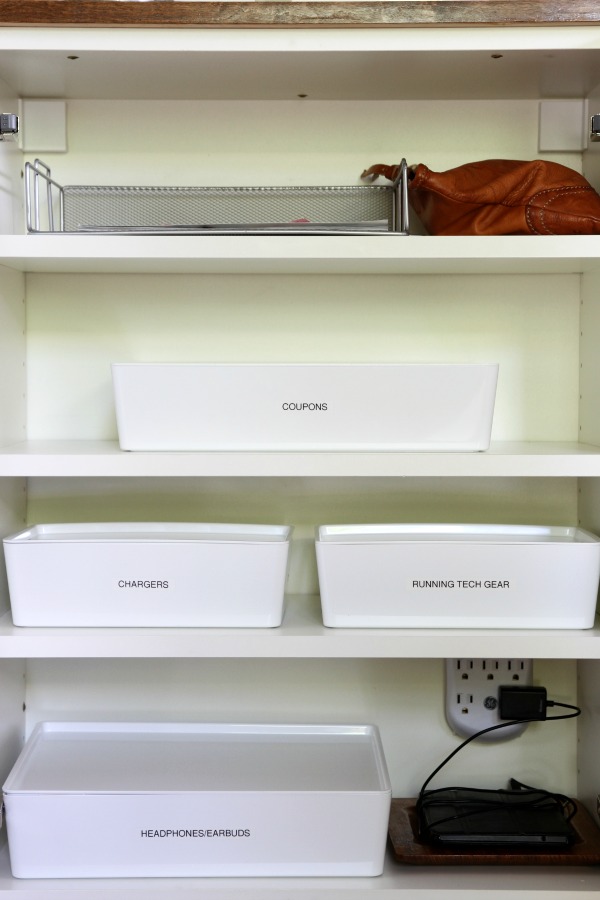
A letter tray on the top shelf holds mail in limbo until it is dealt with at a later time. This usually includes utility and medical bills or cards for the kids. I already mentioned that catalogs and magazines end up in the wall rack. I recently added and labeled several KUGGIS boxes to house coupons and tech accessories and keep them separate from mail. The coupons are simply waiting to be taken out to a folder in the car where I’m more likely to remember to use them. The KUGGIS series is functional and eco-friendly featuring variously sized boxes made from recycled plastic bottles that can be stacked on top of each other to organize paperwork, games, out of season clothing, art supplies, small media, memorabilia, etc.
Before I brought in the KUGGIS boxes, this cabinet was one big tangled mess of mail and wires. I love that the boxes have lids to keep wiry things like chargers, earbuds and headphones under wraps. I find that the kids have an easier time finding and putting things away when bins and labels are involved.
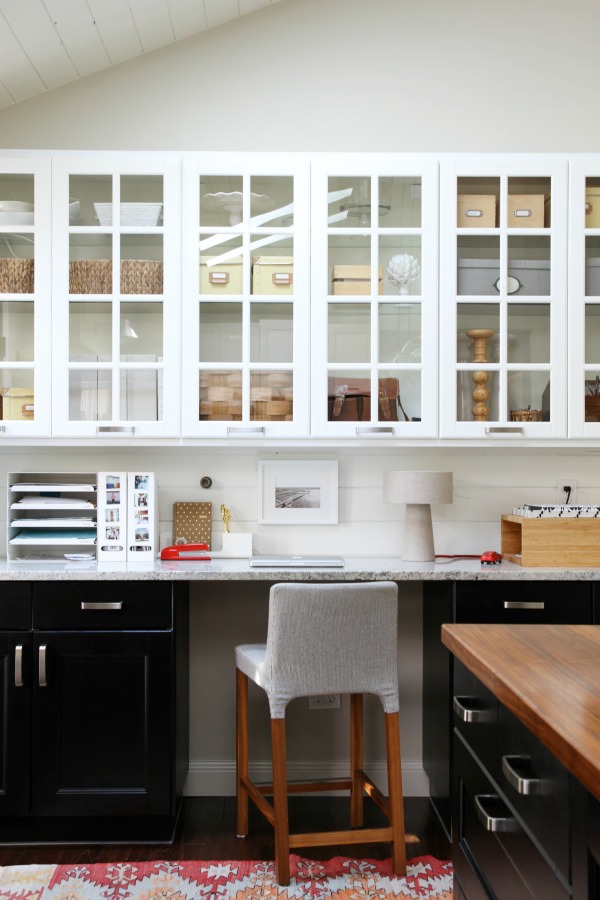
Bills and correspondence that require further attention eventually make their way to the kitchen desk where they’re dealt with appropriately. A recycling pull-out is located at the opposite end of the kitchen near the fridge, and that’s where we discard most paper items.
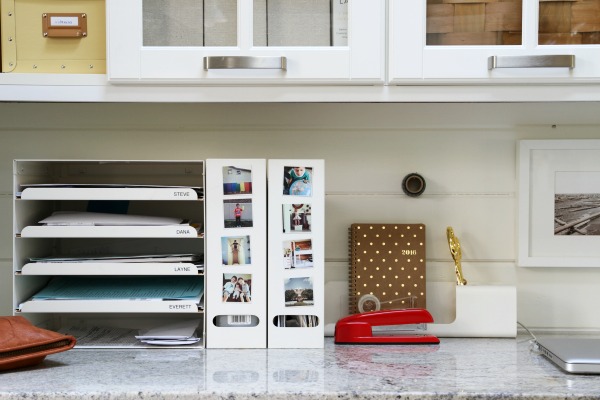
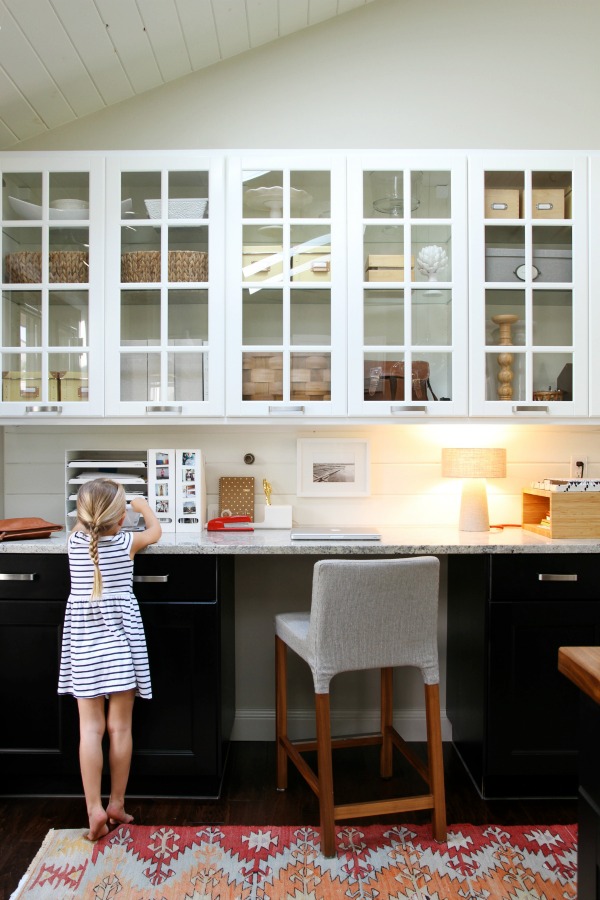
A KVISSLE letter tray holds paperwork that we may need to access within the next month or so: forms to be filled out, receipts, recently paid bills, school calendars, school lunch menus, school pictures to be handed out, kids’ progress reports, fundraising information, etc. They’re mostly things we don’t need to see every day, but they do need to be easily and quickly retrieved when required. Each family member has his/her own tray. (Mabrey’s currently holds two letters to Santa. Ha!) I go through the trays maybe every other month and discard papers that are no longer needed. Again with the labels. I have a passionate but healthy love for my label maker.
A pair of KVISSLE magazine files holds essential oils and favorite recipes. A KVISSLE desk organizer keeps scissors, tape, my planner (#oldschool) and pens within easy reach. If you can’t tell, I fell hard for the KVISSLE series. I’ve had these pieces for more than two years. The steel + cork designs have held up superbly. They’re like brand new. I like displaying tiny photo magnets on the magazine files.
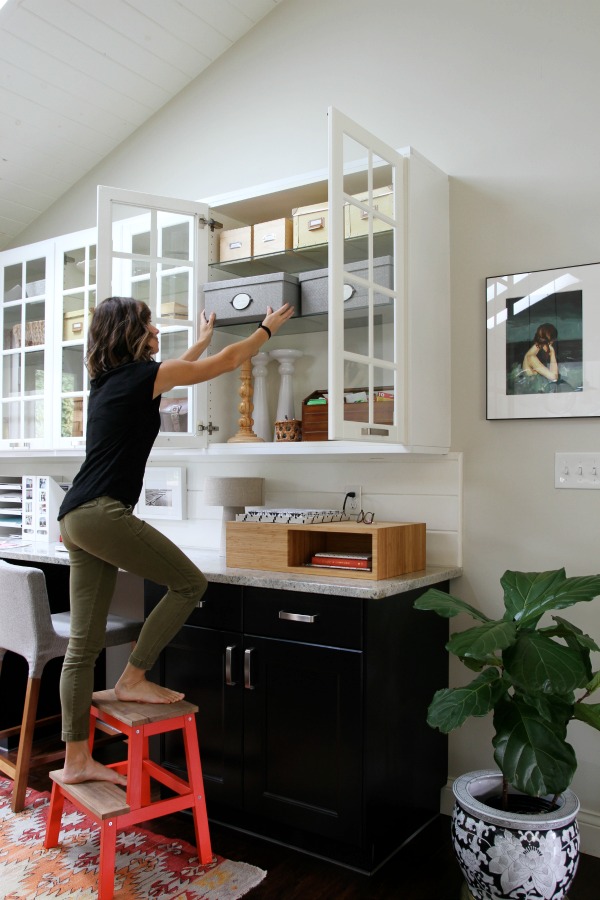
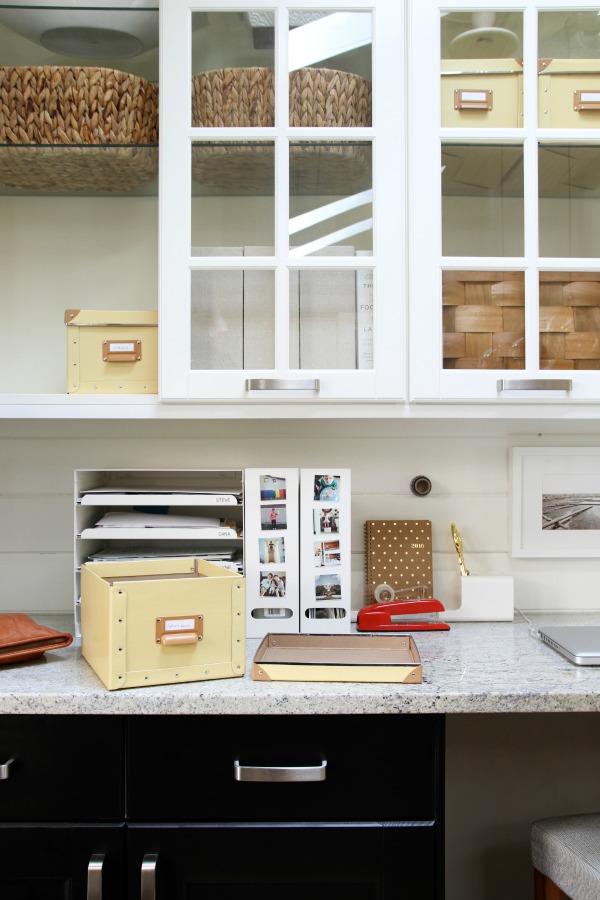
Fortunately, we have plenty of overhead cabinetry that allows us to store important documents for longer periods of time. These are things that we need to keep on hand for a year or more: my pharmacist C.E.s, tax-related paperwork, receipts for tax deductions, vaccination records, etc. The most important legal documents (i.e., Social Security cards, passports, birth certificates, wills, marriage license, insurance policies, etc.) are kept in a fireproof safe elsewhere.
I bought the gray KVARNVIK boxes years ago and still love them. Steve is a bit of a paper hoarder when it comes to saving receipts and paid bills, so I always make sure to have a few boxes on hand for him. He sorts through them eventually. As our family grows, I’m finding that we need less decorative, more functional items in the glass-fronted cabinets. I recently purged a few candleholders I hadn’t used in years to make room for several FJÄLLA boxes. (They’re super easy to assemble, not like the IKEA photo boxes from several years back that were crazy labor intensive.) They’re mostly empty except for a few greeting cards, stamps, markers and vitamins. I like having room to grow. The BEKVÄM step stool gets a lot of action at our house. See how I customized it with paint and stain here.
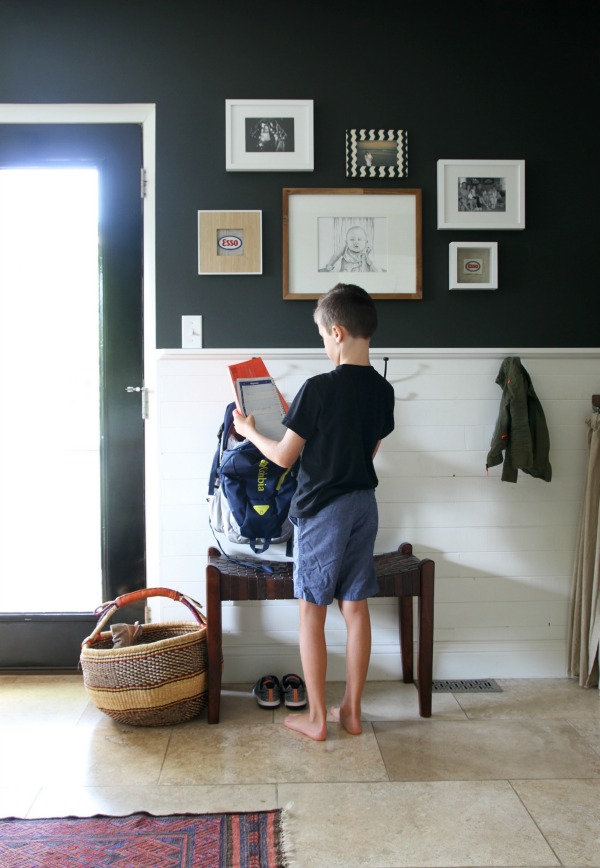
The kids’ school communication is handled much like mail. I opt to receive school newsletters and announcements via email. Layne’s school sends home correspondence once a week on Tuesdays which I LOVE. One shot and I’m done for the week! Everett’s teacher utilizes a classroom text messaging app just for parent-teacher communication regarding class parties, field trips, fundraisers, special events, volunteering, etc. What does end up coming home is sorted and dealt with as soon as possible. I have no tray or bin in place for daily school communication or homework. It’s either in a backpack or being tackled. The boys have the routine down. They hang up their backpacks and immediately get out any homework and their school communication folders. They tend to their homework and eat a snack while I sort and deal with school notices.
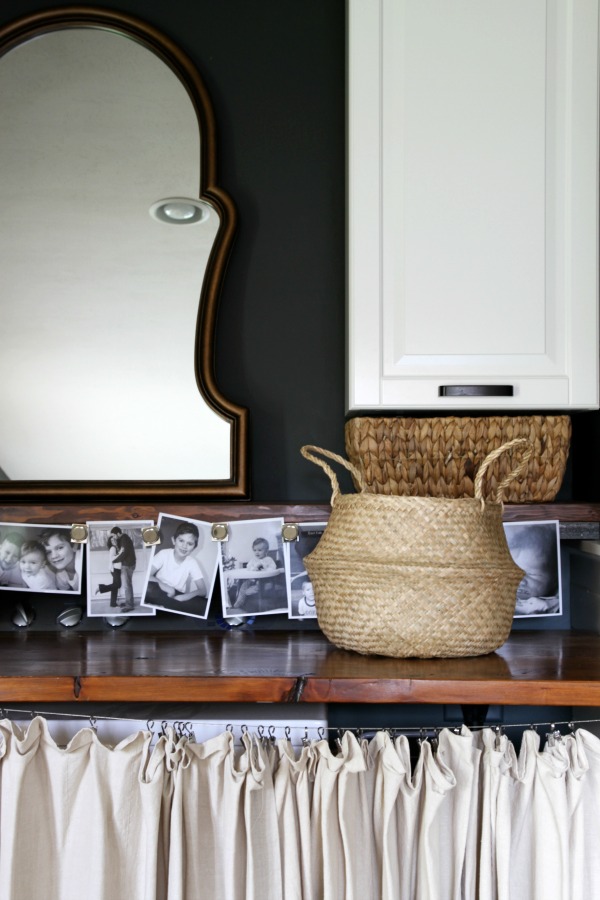
We have one catchall basket in the laundry nook for stashing random items that don’t really have a place elsewhere or were left in pockets of dirty clothes. Right now its contents include origami stars, paper airplanes, paper poppers, several pairs of sunglasses, a baggie of loose coins and a tennis ball I caught from an Andy Murray service fault earlier this summer. (!) Yep, Andy Murray’s DNA is in that basket. I originally stuck a smaller bowl in this spot, but it didn’t take much for it to overflow. I grabbed the larger, taller FLÅDIS basket on my last trip to IKEA so now I can catch all the tennis balls! Haha.
I hope that gives you a little more insight into how we tackle the paper trail in our home. A few key takeaways:
*Opt out of superfluous mail.
*If possible, sort delivered mail before bringing it inside.
*Create a drop zone that isn’t the dining table (or kitchen countertop) to avoid misplacing important mail.
*Use open filing systems for documents needed on a short-term basis. Try a wall rack for unread magazines and catalogs.
*Use lidded boxes or bins for documents needed for longer periods of time. Store important legal documents in a fireproof safe.
*Label trays, bins and boxes to make organization foolproof for the whole family. (I have a Brother P-Touch label maker and love it!)
*Treat school communication like mail. Check with your child’s school to see if they offer an online newsletter or other non-paper communication.
*Tweak the system as your family’s needs change. Keep empty bins on hand and devote one basket to random stuff.
*RECYCLE!
Do you have any tips to share for tackling and organizing the inevitable paper trail?
I am a brand ambassadör for IKEA. This post sponsored in part by IKEA. I received product and payment for this collaboration. IKEA is a registered trademark of Inter IKEA Systems B.V. and is used with permission. The views, ideas and opinions expressed here are my own. Thank you for supporting the brands that support this blog!
images: Dana Miller for House*Tweaking































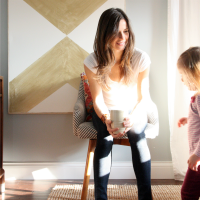








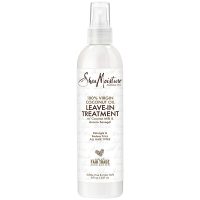
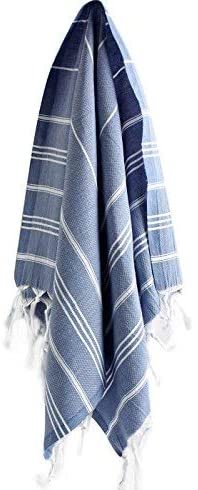
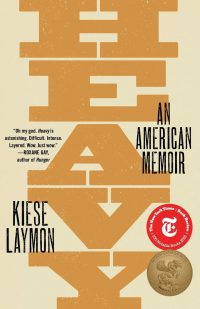

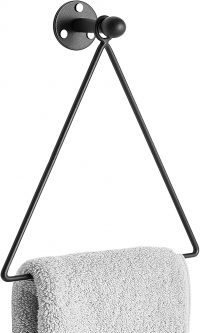





DIY, renovation